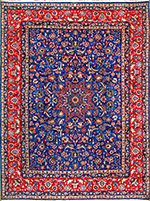Textiles Studies

Textile Research Works
Date of this Version
2003
Document Type
Article
Abstract
Mamluk rugs are considered by many to be among the most beautiful of any rugs ever created. The brilliant reds, greens, and blues (figs. 1 and 2) are reminiscent of rubies, emeralds and sapphires; whether this was an intentional evocation is not known. But The Textile Museum's holdings of Mamluk rugs, unparalleled in the world, are truly the "jewels" of the collection. Simply by virtue of the fact that they date from the late 15th century, Mamluk rugs comprise one of the most significant groups of classical carpets. Their lustrous wool and wondrous color, as well as their geometric designs and careful execution, contribute to the characteristics of a cohesive group from the points of view of design, structure, materials, color, and layout. Yet, this is also a group for which many questions remain unanswered.
The emergence of this unique group rests upon no known development of rug-weaving traditions. Nor is the influence of the three-color geometric patterns of Mamluk rugs felt in later traditions. In contrast, the weave structure of Mamluk carpets is retained in Cairene carpets manufactured immediately after the Ottoman conquest of Egypt in 1517, which share technical characteristics, while reflecting newly emergent Ottoman floral styles.
Despite such uncertainties of origin and early development, Mamluk rugs show an exceptionally high degree of uniformity, more so perhaps than in any other group of rugs prior to industrialization and mechanized production. Two rugs in the exhibition (figs. 1 and 2) demonstrate consistency of dimension, color, structure and layout, the proportions of which are determined geometrically. Larger rugs also show a proportion based on geometry of the circle and the square.
Included in
Art and Materials Conservation Commons, Art Practice Commons, Fiber, Textile, and Weaving Arts Commons, Indigenous Studies Commons, Museum Studies Commons

